Jama, Jan 10, 1966, Vol 195, No 2, 125-129
Municipal Drinking Water and Cardiovascular Death Rates
Henry A. Schroeder, MD
The association of the degree of softness of municipal
water and death rates from hypertension and arteriosclerotic
heart diseases, demonstrated for 1949 to 1951 rates, persisted in
1960. Statistical analyses of death rates from 88 cities of the
United States with levels of bulk and trace elements in municipal
water supplies showed negative correlations for 12 major and 4
trace constituents. The purer the water in terms of dissolved
elements, the higher was the death rate from this cause. No trace
element of 19 measured was found highly correlated. One possible
explanation of this phenomenon involves the corrosive quality of
soft water for metal pipes in dwellings.
An association between death rates from hypertensive and
arteriosclerotic heart diseases and degree of softness of
municipal water in the United States was demonstrated on rates
for 1949 to 1951 [1,2]. This association was quickly confirmed in
Great Britain by Morris and his colleagues [3]. No such
relationship was found for other heart diseases or other major
causes of death. Recently, Biörck and his colleagues showed
highly significant negative correlations between calcium in
drinking water and death rates from degenerative heart disease in
Swedish males [4]. Previously, Kobayashi [5], had pointed out an
apparent geographical relation in Japan between death rates from
cerebrovascular accidents and the sulfate: bicarbonate ratios of
river water, suggesting a basis for examining variations in
specific mortality according to geochemical patterns; his data
were found significant [6]. Almost all river water in Japan is
soft, with hardness less than 40 ppm [7], compared with a mean
hardness for raw municipal water in the United States of 139 ppm,
for surface waters of 94 ppm, and for ground waters of 192 ppm
[8]. In Sweden mean hardness was 65 ppm [4].
None of these investigators was able to identify any single
constituent of potable water as being closely correlated with
cardiovascular death rates except perhaps calcium [8]. This
element and the major anions inversely correlated fairly well
with death rates from arteriosclerotic heart disease in 163
cities of the United States [1] and in 83 county boroughs of
England and Wales. On the other hand, only the cardiovascular
diseases considered secondary to atherosclerosis and hypertension
were related to the degree of softness of water.
Recently Durfor and Becker published data on 18 bulk and 19
trace constituents in municipal waters from the 100 largest
cities in the United States. Sauer had compiled death rates from
arteriosclerotic heart in white males for most of these cities
[10]. Therefore, the present study was made in an attempt to
refine or exclude factors, both bulk and trace, in potable water
which may or may not be related to death rates from these
causes.
Materials and Methods
Death rates of white persons for 1960, age-adjusted, for 49
states and the District of Columbia, divided into the major
cardiovascular diseases [11], were compared with weighted average
hardness of municipal (finished) waters, by state, consumed by a
majority of the population.[8] Data were confined to white
persons, as the proportion of non-whites to whites is increased
in many of the states with water softer than average [2], and as
the mortality from hypertensive heart disease of nonwhite persons
is often several times greater than that of whites [11].
Cities with published mortalities for arteriosclerotic
(coronary) heart disease in white males aged 45 to 64 years [10]
were compared with cities whose municipal supplies had been
analyzed for the concentrations of major constituents and of
trace elements in finished water [9]. Data both for death rates
and for water were complete for 88 cities. Tap water from private
dwellings was not analyzed.
The data were fed into a digital computer capable of
calculating 625 coefficients of rank correlation (r)
simultaneously. (1) Death rates from arteriosclerotic heart
disease, hypertensive heart disease, and vascular lesions
affecting the central nervous system were compared with water
hardness by state; (2) death rates from arteriosclerotic heart
disease in white males compared with 18 constituents of water in
88 cities; (3) death rates from arteriosclerotic heart disease in
white males were compared with 23 qualities of water in the 25
cities with the highest and the 25 cities with the lowest rates;
(4) constituents of water were compared with each other. The
degree of significance of coefficients of correlation were
obtained from standard tables. Differences in each constituent of
water in the two groups of cities were determined by Student's
t-test.
Analyses could not be made of death rates by city for diseases
with much lesser incidences than that of arteriosclerotic heart
disease, because of unreliability of the data. Those of the major
cardiovascular were reasonably accurate in larger, state-wise
populations [11].
Results
The inverse correlation of death rates from certain
cardiovascular diseases by state and weighted average hardness of
water was again present for 1960 rates (Table 1). The correlation
coefficients were significant (P < 0.005) for
hypertensive heart disease and for arteriosclerotic heart disease
in both sexes. For vascular diseases of the central nervous
system, a coefficient of doubtful significance appeared for white
males, lower than previously found [2]. No relationships were
evident between any of these variables and effective buying
income per capita, a socioeconomic index.
Table 1.--Coefficients of Correlation (r) of Death
Rates in White Persons From Major Cardiovascular Diseases and
Weighted Average Hardness of Municipal Waters by State,
1960
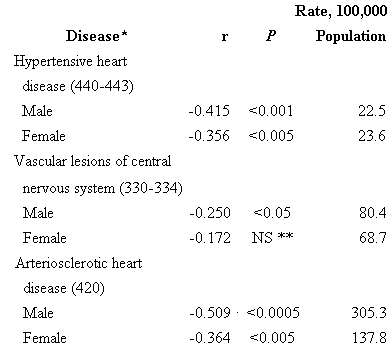
* Numbers in parentheses refer to categories in
the International Statistical Classification of Diseases,
Injuries and Causes of Death, Seventh revision (1955),
Geveva: World Health Organization, 1957, vol 1.
** NS= not significant.
Death rates from the three conditions considered were tested
for relation to each other. There were good correlations between
white persons dying of hypertensive heart disease and
arteriosclerotic heart disease (males, r = 0.57; females, r =
0.43, P < 0.005) in the several states. Relationships
between hypertensive or arteriosclerotic heart disease and
vascular lesions affecting the central nervous system were not
significant.
Significant relations of death rates from arteriosclerotic
heart in white males aged 45 to 64 years and 23 constituents of
water from 88 cities are given in Table 2. Those with potassium,
specific conductance (total electrolytes), and hardness are
especially evident, associated with most of the major
constituents, all of which had negative coefficients. Of the
trace substances, positive coefficients were found for copper and
manganese. Death rates from all causes did not show significant
correlations with any variable in water.
Table 2.--Coefficients of Correlation (r) of Death
Rates From Arteriosclerotic Heart Disease, White Males, Aged 45
to 64 Years, and Certain Major and Minor Constituents of
Municipal Waters from 88 Cities*
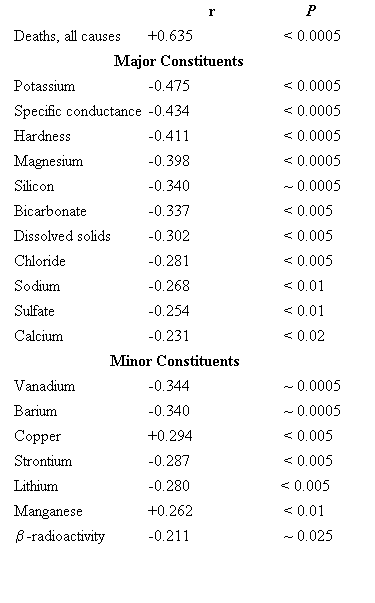
* Only correlation coefficients greater than 0.178, P=0.05,
are included. Negative coefficients less than 0.178 were found
for noncarbonate hardness, aluminum, boron. Coefficients were
small for nickel and lead.
Significant differences in the bulk and trace constituents of
water from the 25 cities with the highest and the 25 cities with
the lowest death rates from arteriosclerotic heart are given in
Table 3. The water associated with high death rates had less
conductance, hardness, magnesium, sodium, potassium, sulfate, and
barium and more copper (P < 0.01). It may have had
significantly less solids, bicarbonate, chloride, silicon,
lithium, strontium, and vanadium (P < 0.05). Although
it also contained less calcium and aluminum, and more manganese
and nickel, the differences were not significant. The means of
the two groups of waters were quite similar in content of boron,
chromium, fluorine, iron, molybdenum, lead, rubidium, and
titanium and in pH.
Table 3.--Significant Differences in Constituents of
Water in 25 Cities With Lowest and 25 Cities With Highest Death
Rates From Arteriosclerotic Heart Disease, White Males, Aged 45
to 64 Years, Mean ± SE
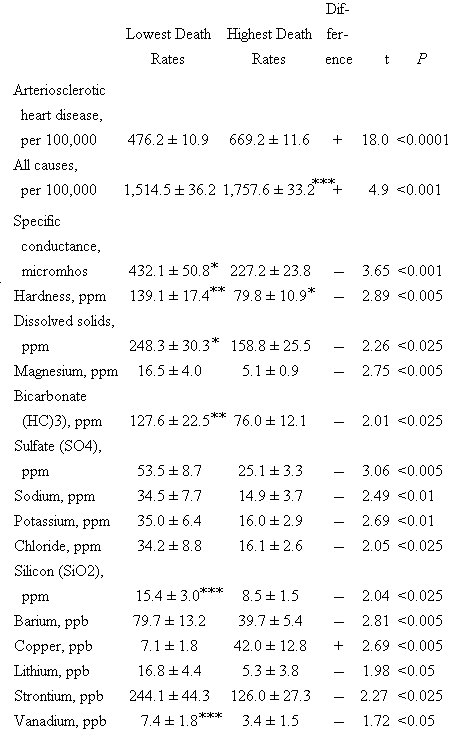
Coefficients of correlation with death rates from
arteriosclerotic heart disease within group (All coefficients
were negative):
* > 0.381, P <0.025
** > 0.445, P <0.01
*** > 0.0597, P <0.0005
Therefore, qualities of water associated with total
electrolytes and the concentrations of the alkali metals and
alkaline earths were related to death rates from coronary heart
disease in such a way that the higher the death rate, the less
were such constituents in water. Conversely, the higher the death
rate, the greater were the concentrations of copper and possibly
manganese in water.
In order to refine these differences, the concentrations of
water constituents and death rates in each of the two groups of
cities were correlated by rank. Death rates from coronary heart
disease in the 25 cities with high rates were significantly
related to water qualities as follows: inversely with lead
(P < 0.005) and hardness (P < 0.25);
directly with manganese (P < 0.005). In 25 cities
with the lowest rates, deaths from coronary disease were
significantly related as follows: inversely with silicon and
vanadium (P < 0.005); bicarbonate and hardness
(P < 0.01); specific conductance, solids, and boron
(P < 0.025); and directly with no element. Therefore,
no significant correlation with death rates appeared for any
measured element or quality of water common to the two groups of
cities, except hardness.
As expected, specific conductance was directly and highly
related to the concentrations of the bulk elements, total solids,
and hardness. Positive coefficients were also found for the trace
elements barium, strontium, aluminum, molybdenum, lead, titanium,
boron, vanadium, and lithium in varying degrees of significance.
Negative correlations, when found, were low.
Comment
The relationship of death rates from hypertensive and
arteriosclerotic heart in white persons by state and some factor
of potable water related with softness, previously demonstrated
for 1950 rates, persisted in 1960. This phenomenon recurred in
spite of a decline in the mortality of white males from
hypertensive heart disease of 45.8% and a rise in mortality from
atherosclerotic heart disease of 10.8% during the decade [11].
That the known geographic variation of death rates from specific
cardiovascular disorders can be linked to some quality in water
in such different areas of the world as the United States [1,2],
Great Britain [3], Japan [5], and Sweden [4], suggests that the
association is real. It was the purpose of this study to attempt
to discover which constituents in water an so associated, in
order to indicate further research on environmental factors
influencing these diseases.
That the purity of water in terms of inorganic material is
directly related to death rates from arteriosclerotic heart
disease in white males deserves explanation. If this relationship
is valid and a real influence exists, two hypotheses must be
explored: (1) Some substance dissolved in water partly protects
or guards against the disease or (2) some quality in pure water
enhances the disease.
Hardness of water depends upon the formation of insoluble
calcium and magnesium soaps, and not upon sodium or potassium.
Hardness was the only available measurement of water on a
statewide basis with which to correlate specific death rates. Of
the 50 cities with high and low death rates, 11 provided softened
municipal waters. Four of those with high rates reduced hardness
to 82 ppm ± 3.36 (standard error of the mean [SE]); seven
with low rates to 129 ppm ± 9.65 (SE), (P <
0.005). Thirty of the 100 cities reported softened their supplies
[9].
In softer waters, specific conductance and hardness were
directly related to the bulk elements and to aluminum, barium,
chromium, molybdenum, lead, strontium, fluorine, and titanium. In
harder waters, they correlated significantly with the bulk
elements and barium, strontium, lithium, vanadium, and boron. In
no case was the amount of one of these substances in water a
substantial increment of the amount normally present in food,
except perhaps that of silicon (Table 4). From what is known of
these elements at this time, none (with the possible exception of
lead) can be implicated in the pathogenesis of either
hypertensive or coronary heart disease, nor does the data
implicate any single element, major or trace, in water as
possibly retarding the disease.
Table 4.--Approximate Daily Human Intakes of Several
Elements From Food and Water, Values for Cities With Lowest Death
Rates*
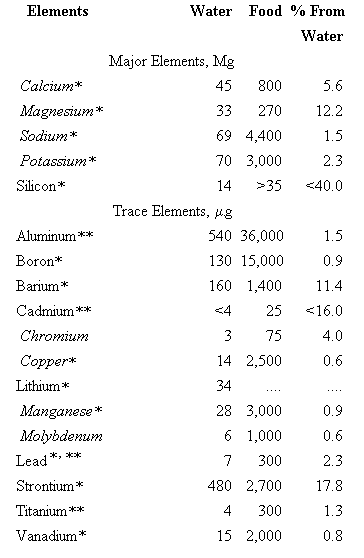
* Values for water from Table 3 and
Durfor and Becker(9), assuming 2 liters intake per day; for food
from Underwood (12), Altman and Dittmer (13), and Schroeder (14).
Elements believed essential for man are in Italics.
** Correlation with death rates from arteriosclerotic
heart disease in one or more analysis.
*** Accumulates in man (18).
Cumulative trace elements have been suspected of influencing
cardiovascular disorders, especially cadium in hypertension [15].
Chromium deficiency in rats is associated with aortic plaques
[16]. Cadmium was not detected in municipal water by the method
used [9], athough it was found frequently in tap water in the
United States [17] and in river water in Japan [18] by other
methods. Chromium did not differ in the waters of the two groups
of cities. According to these statistics, six trace elements in
water correlated inversely with death rates and two essential
micronutrients correlated directly. Insofar as is known, none of
these accumulates in man, except lead [14] (Table 4), which had a
negative coefficient. If a toxic trace element is influencing the
disease adversely, it is probably not among those measured.
The data from the United States [1,2], Great Britain [3],
Sweden [4], and Japan [5] suggest that some quality of water
associated with but other than those measured may influence
cardiovascular death rates. The waters associated with the
highest death rates in all four areas were of a nature considered
corrosive to metal pipes. The ability of water to dissolve metals
from pipes depends directly upon the degree of softness and the
concentrations of carbonic acid, alkaline bicarbonates,
chlorides, and sulfates. Soft waters tend to contain carbon
dioxide and bicarbonate. Soft waters high in sulfate, as in
Japan, are especially corrosive. Hard waters do not ordinarily
attack pipes unless they have been softened, in which case sodium
bicarbonate, replacing calcium bicarbonate, induces corrosion.
When this water is heated, free carbon dioxide is formed, making
hot water more corrosive than cold water.
This investigation concerns water in municipal supplies and
not water consumed from the tap, which has stood in and
circulated through mains and pipes in buildings. Therefore, trace
metals can. not be completely excluded as affecting
cardiovascular mortality. Soft water may absorb considerable
metal from pipes. In Table 5 are the results of analyses of used
water pipes and water from two private dwellings and two
hospitals. Some values for copper exceeded the rnaximum found in
100 municipal waters, 250 ppb [9].
Table 5.--Trace Elements in Water Pipes and Tap Waters
Standing Therein*
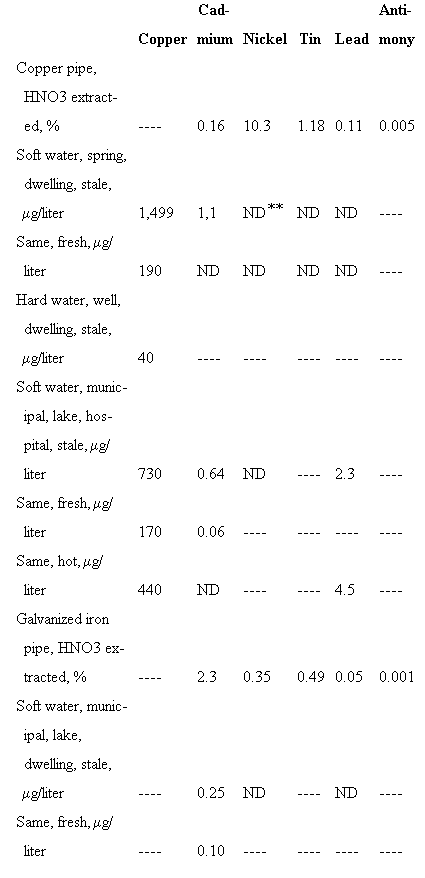
*Short sections of used pipe were extracted with 1
N HNO3 for 24 hours. Stale water from tap after standing
overnight; fresh water after running 15 minutes or more. Spring
water had 18 ppm hardness; municipal water, 20 ppm. Spring water
standing in laboratory dissolved from a section of copper pipe
153 µg of copper per 100 sq cm surface per day at pH
7.0.
**ND = not detected.
The corrosiveness of soft water is a constant problem in
municipal water works and private dwellings [19]. In water works,
brass fittings may contain the alloying metals, nickel, aluminum,
arsenic, antimony, and tin. In older private houses, copper pipes
and fixtures may contain tin, arsenic, and cadmium. The modern
copper tubing widely used in the United States, however, has only
contaminants of other metals, aside from lead and tin in solders.
Galvanized iron pipes expose water to cadium, a contaminant of
zinc [17]. As lead, tin, and cadmium accumulate in man [14],
these and perhaps other metals require investigation as to their
inlfluence upon atherosclerosis or hypertension.
The association of water and death rates from two common
cardiovascular diseases has been declared "spurious" by Dingle et
al [20], who pointed out that states having a seacoast showed
higher death rates than states without. They used "cardiovascular
disease" (International Causes of Death, sixth revision, No.
330-334 and 400-418) [21], however, as a single factor, whereas
it was composed of ten [11]. Such statistical pitfalls are all
too common. In fact, coefficients of correlation of hardness of
water and death rates from hypertensive heart disease in white
persons aged 55 to 64 years were -0.501 in coastal and -0.518 in
interior states (P < 0.005), hardly a spurious
association. This relationship, however, is not evident in
smaller geographical areas with lesser populations. Neither in
Ireland [22], where water is often soft, nor in Oklahoma [23]
where water is generally hard, and death rates from these causes
below average, was it demonstrable. If corrosion is a factor,
these negative results might be expected in hard-water areas or
where pipes in dwellings are dissimilar to the type used in the
United States.
References
1. Schroeder, H.A. : Relation Between Mortality From
Cardiovascular Disease and Treated Water Supplies. JAMA
172:1902-1908 (April 23) 1960
2. Schroeder, H.A. : Relations Between Hardness of Water and
Death Rates from Certain Chronic and Degenerative Diseases in the
United States. J Chron Dis 12;586-591
(Dec) 1960
3. Morris J; Crawford M.D.; and Heady J.A.: Hardness of Local
Water Supplies and Mortality from Cardiovascular Disease,
Lancet 1;860 (April) 1961.
4. Biorck, G; Bopstrom H; and Widstrom, A.: On the
Relationship Between Water Hardness and Death Rates in
Cardiovascular Diseases, Acta Med Scand
178;239-252 (Aug) 1965.
5. Kobayashi, J: Geographical Relationship Between the
Chemical Nature of River Water and Death-Rate from Apoplexy,
Berichte d Ohara Inst f landwirtsch Biologie
11:12-21 (March) 1957
6. Schroeder, H.A.: Degenerative Cardiovascular Disease in the
Orient: II Hypertension, J Chron Disease
8;312-333 (Sept) 1958.
7. Kobayashi J; A Chemical Study of the Average Quality and
Characteristics of River Waters of Japan; Berichte d Ohara
Inst f landwirtsch Biologie 11;313-358
(March) 1960.
8. Lohr, R.W. and Love, S.K.: Industrial Utility of Public
Water Supplies in the United States 1952: Parts 1 and 2,
Geological Survey Water-Supply Papers 1299 and 1300, Government
Printing Office 1954.
9. Durfor C.N., and Becker E: Public Water Supplies of the
100 Largest Cities in the United States: 1962, Geological
Survey Water-Supply Paper 1812, U. S. Government Printing Office
1964.
10. Sauer H.L.: Epidemiology of Cardiovascular Mortality:
Geographic and Ethnic, Amer J Public Health
52:94-105 (Jan) 1962.
11. Cardiovascular Disease 1960: Data on National and
State Mortality Experience, Public Health Service
Publication No. 1083, US Department of Health, Education and
Welfare. 1964
12. Underwood E.J.: Trace Elements in Human and Animal
Nutrition, ed 2, New York: Academic Press Inc., 1962.
13. Altman P.L., and Ditmer D.S.: Biology Data Book,
Washington DC: Federation of American Societies for Experimental
Biology, 1964.
14. Schroeder H.A.: Biological Trace Elements or Peripatetics
Through the Periodic Table, J Chron Disease
18:217-228 (March) 1965.
15. Schroeder H.A.: Cadmium As A Factor In Hypertension, J
Chron Dis 18:647-656 (July) 1965.
16. Schroeder H.A., and Belassa J.J.: Influence of Chromium,
Cadmium, and Lead on Rat Aortic Lipids and Circulating
Cholesterol, Amer J Physiol 209:433-437
(Aug) 1965.
17. Schroeder H.A. and Belassa J.J.: Abnormal Trace Metals in
Man: Cadmium, J Chron Dis14:236-258
(Aug) 1961.
18. Moritsugu M and Kobayashi J: Study on the Trace Metals in
Bio Materials: (I) Geographical Differences of Metals Contained
in Ayu; (Plecoglossus altivelis), Nogakyu
Kenkyu47;149-188 (No. 3) 1960
19. Corrosion Resistance of Copper and Copper Alloys,
Anaconda Publication B-36, ed 6, Waterbury, Conn.: American Brass
Co. 1959.
20. Dingle J.H., et al.: Water Composition and Cardiovascular
Health, Ill. Med J125:25-31 (Jan)
1964.
21. Manual of the International Statistical Classification
of Disease, Injuries, and Causes of Death, sixth revision,
Geneva, World Health Organization 1948
22. Mulcahy R.: The Influence of Water Hardness and Rainfall
on the Incidence of Cardiovascular and Cerebrovascular Mortality
In Ireland, J Irish Med Assoc 55:17-18
(July) 1964.
23. Lindeman R.D. and Assenzo J.R.: Correlation Between Water
Hardness and Cardiovascular Deaths in Oklahoma Counties, Amer
J Public Health 54:1071-1077 (July)
1964.
This page was first uploaded to The Magnesium Web Site on June
19, 1996
http://www.mgwater.com/





